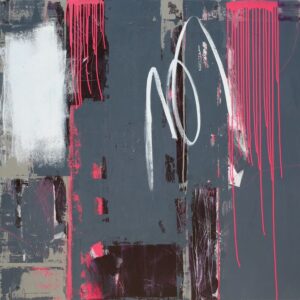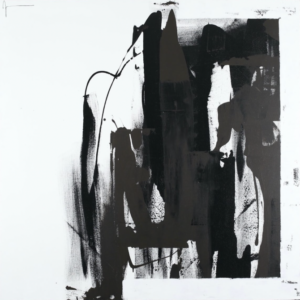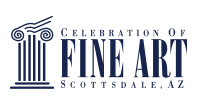The human experience is a nuanced journey filled with seasons of growth and plateaus, joy and sorrow, and light and dark. And for abstract artist Jessamyn Parker, art has been a channel for exploring and expressing those seasons and shared experiences.
Guided by her intuition, Jessamyn’s compositions are organic, often exploring themes of growth. And while some pieces originate from the deeper exploration of a personal journey, they ultimately tap into the ubiquitous emotions every human journeys through––and it’s that spark of connection that Jessamyn covets.
Through mark making, abstract shapes, color and texture, each piece shares a rich story. And though she’s not always clear on what that story is going to be at the beginning, it always reveals itself in the end.
In this interview, Jessamyn shares how she explores and expresses the human experience through her abstract art, and how physical movement helps guide the process.
Q&A with Jessamyn:
When did you know art was your calling?
I knew from a really young age. I was always drawing and doodling. I was also physically in the arts and ballet, and things like that. It was in my mind, my heart and also in my body. I kind of paint that way too––using a lot of energy and physical energy around my larger scale paintings.
So, it started young and carried all the way through college, and then I kind of took a break from painting for a little while and came back to it.
What do you love most about the creative process?
It mirrors growth as a human. I really paint about the human experience and my human experience, personally. It’s sort of a way to mirror growth in life and in art. They do mirror each other and so any phase of growth that I may be going through or the world is going through, that can come through into a painting or a piece of artwork, and that’s pretty special.
How do you convey the human experience through your work?
I learned to do that personally as a kid. Physically, I was a gymnast, runner and a ballerina. I was always really active and I think to have another tool to come through me when I was introduced to whatever tools I had as a kid, like crayons or whatever I had. That then, of course, evolved as I went to school and went through art school.
It feels natural to me and kind of intuitive. Imagining a color or a shape, or even, more importantly, a feeling and having a tool like an oil pastel or a paintbrush or even just my hands with some kind of medium to be able to manifest that into a space like a canvas feels really natural.
How has your creative journey evolved?
When I was in school, they tell you what to paint. Then I moved more into an abstract department where I felt a lot more freedom to do that intuitive expression where I wasn’t sure what was going to come out, but every time it did, it was really interesting and exciting. I’ve become more and more conceptual and I don’t necessarily have a plan.
A shape or a color may come in that I want to include, but I never really know until it’s done what I was trying to express. So it’s kind of a fun process to move through. It’s like a mini metaphor for life in each painting.
What is the most rewarding aspect of what you do?
To be able to see the start and finish of a journey. You have this blank space or nothing, and then you’re creating something and you’re eventually left with a feeling or something that feels important to you that you’re sharing. And just to have a witness to that is pretty exciting. Then to be able to connect with another human and feel seen––they get you and you get them and you have something in common, I think is really what life is kind of about. That is the most rewarding when you reach someone and you find connection between the painting and the person or between you, the painting and the person––you have something in common.
What brought you to the Celebration of Fine Art?
Definitely the connection to all the other artists. The camaraderie. Everyone here is just like your instant family. You feel safe, it’s fun and you help grow each other’s work and expand it.



